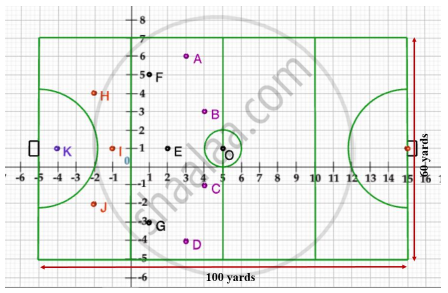Advertisements
Advertisements
Question
The length of line PQ is 10 units and the co-ordinates of P are (2, -3); calculate the co-ordinates of point Q, if its abscissa is 10.
Solution
Let the co-ordinates of point Q be (10, y).
PQ = 10
PQ2 = 100
(10 - 2)2 + (y + 3)2 = 100
64 + y2 + 9 + 6y = 100
y2 + 6y - 27 = 0
y2 + 9y - 3y - 27 = 0
y(y + 9) - 3(y + 9) = 0
(y + 9) (y - 3) = 0
y = -9, 3
Thus, the required co-ordinates of point Q are (10, -9) and (10, 3).
APPEARS IN
RELATED QUESTIONS
If the point P(x, y) is equidistant from the points A(a + b, b – a) and B(a – b, a + b). Prove that bx = ay.
If P (2, – 1), Q(3, 4), R(–2, 3) and S(–3, –2) be four points in a plane, show that PQRS is a rhombus but not a square. Find the area of the rhombus
Find the distance between the points
(ii) A(7,-4)and B(-5,1)
Using the distance formula, show that the given points are collinear:
(-2, 5), (0,1) and (2, -3)
If A and B are the points (−6, 7) and (−1, −5) respectively, then the distance
2AB is equal to
Find the value of y for which the distance between the points A (3, −1) and B (11, y) is 10 units.
Prove that the points (7 , 10) , (-2 , 5) and (3 , -4) are vertices of an isosceles right angled triangle.
Show that the points (2, 0), (–2, 0), and (0, 2) are the vertices of a triangle. Also, a state with the reason for the type of triangle.
Find the distance between the origin and the point:
(-8, 6)
Show that the points P (0, 5), Q (5, 10) and R (6, 3) are the vertices of an isosceles triangle.
Given A = (3, 1) and B = (0, y - 1). Find y if AB = 5.
Given A = (x + 2, -2) and B (11, 6). Find x if AB = 17.
Find the distance of the following points from origin.
(a+b, a-b)
Show that the points (a, a), (-a, -a) and `(-asqrt(3), asqrt(3))` are the vertices of an equilateral triangle.
Show that the points (2, 0), (– 2, 0) and (0, 2) are vertices of a triangle. State the type of triangle with reason
AOBC is a rectangle whose three vertices are A(0, 3), O(0, 0) and B(5, 0). The length of its diagonal is ______.
The distance of the point (α, β) from the origin is ______.
Case Study -2
A hockey field is the playing surface for the game of hockey. Historically, the game was played on natural turf (grass) but nowadays it is predominantly played on an artificial turf.
It is rectangular in shape - 100 yards by 60 yards. Goals consist of two upright posts placed equidistant from the centre of the backline, joined at the top by a horizontal crossbar. The inner edges of the posts must be 3.66 metres (4 yards) apart, and the lower edge of the crossbar must be 2.14 metres (7 feet) above the ground.
Each team plays with 11 players on the field during the game including the goalie. Positions you might play include -
- Forward: As shown by players A, B, C and D.
- Midfielders: As shown by players E, F and G.
- Fullbacks: As shown by players H, I and J.
- Goalie: As shown by player K.
Using the picture of a hockey field below, answer the questions that follow:

The point on y axis equidistant from B and C is ______.
What type of a quadrilateral do the points A(2, –2), B(7, 3), C(11, –1) and D(6, –6) taken in that order, form?
Ayush starts walking from his house to office. Instead of going to the office directly, he goes to a bank first, from there to his daughter’s school and then reaches the office. What is the extra distance travelled by Ayush in reaching his office? (Assume that all distances covered are in straight lines). If the house is situated at (2, 4), bank at (5, 8), school at (13, 14) and office at (13, 26) and coordinates are in km.
